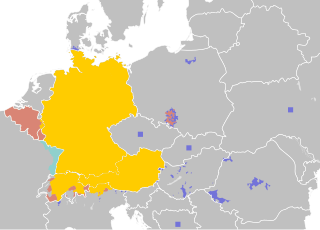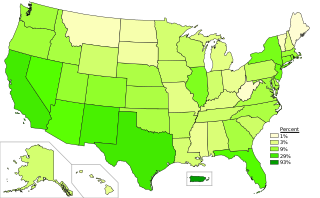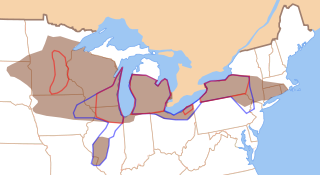See also
- New York (disambiguation)
- List of dialects of the English language, a list of varieties that differ in pronunciation, vocabulary and grammar
New York English describes the varieties of English spoken within New York (state), the most well-known of which is perhaps New York City English.
New York English, the New York dialect or the New York accent may refer to:
The terms above may also refer to New York Latino English, a Hispanic American ethnolect originating in New York City, also referred to as East Coast Latino English.
American English, sometimes called United States English or U.S. English, is the set of varieties of the English language native to the United States. English is the most widely spoken language in the United States and in most circumstances is the de facto common language used in government, education and commerce. Since the late 20th century, American English has become the most influential form of English worldwide.

German is a West Germanic language mainly spoken in Western Europe and Central Europe. It is the most widely spoken and official or co-official language in Germany, Austria, Switzerland, Liechtenstein, and the Italian province of South Tyrol. It is also an official language of Luxembourg and Belgium, as well as a recognized national language in Namibia. Outside Germany, it is also spoken by German communities in France (Alsace), Czech Republic, Poland, Slovakia, and Hungary (Sopron).

Mandarin is a group of Sinitic dialects that are natively spoken across most of northern and southwestern China. The group includes the Beijing dialect, the basis of the phonology of Standard Chinese, the official language of China. Because Mandarin originated in North China and most Mandarin dialects are found in the north, the group is sometimes referred to as Northern Chinese. Many varieties of Mandarin, such as those of the Southwest and the Lower Yangtze, are not mutually intelligible with the standard language. Nevertheless, Mandarin as a group is often placed first in lists of languages by number of native speakers.
Spoken English shows great variation across regions where it is the predominant language; the United Kingdom has a wide variety of accents, and no single "British accent" exists. This article provides an overview of the numerous identifiable variations in pronunciation; such distinctions usually derive from the phonetic inventory of local dialects, as well as from broader differences in the Standard English of different primary-speaking populations.

The United States does not have an official language at the federal level, but the most commonly used language is English, which is the de facto national language. It is also the language spoken at home by the great majority of the U.S. population. Many other languages are also spoken at home, especially Spanish, according to the American Community Survey (ACS) of the U.S. Census Bureau; these include indigenous languages originally spoken by Native Americans, Alaska Natives, Native Hawaiians, and native populations in the U.S. unincorporated territories. Other languages were brought in by people from Europe, Africa, Asia, other parts of the Americas, and Oceania, including multiple dialects, creole languages, pidgin languages, and sign languages originating in what is now the United States. Interlingua, an international auxiliary language, was also created in the U.S.

Spanglish is any language variety that results from conversationally combining Spanish and English. The term is mostly used in the United States and refers to a blend of the words and grammar of the two languages. More narrowly, Spanglish can specifically mean a variety of Spanish with heavy use of English loanwords.

Spanish is the second most spoken language in the United States. Over 42 million people aged five or older speak Spanish at home. Spanish is also the most learned language other than English, with about 8 million students. Estimates count up to 57 million native speakers, heritage language speakers, and second-language speakers. There is an Academy of the Spanish Language located in the United States as well.

Over 50 million Americans claim German ancestry, which makes them the largest single claimed ancestry group in the United States. Around 1.06 million people in the United States speak the German language at home. It is the second most spoken language in North Dakota and is the third most spoken language in 16 other states.
Southern American English or Southern U.S. English is a regional dialect or collection of dialects of American English spoken throughout the Southern United States, though concentrated increasingly in more rural areas, and spoken primarily by White Southerners. In terms of accent, its most innovative forms include southern varieties of Appalachian English and certain varieties of Texan English. Popularly known in the United States as a Southern accent or simply Southern, Southern American English now comprises the largest American regional accent group by number of speakers. Formal, much more recent terms within American linguistics include Southern White Vernacular English and Rural White Southern English.
New Orleans English is American English native to the city of New Orleans and its metropolitan area. Native English speakers of the region actually speak a number of varieties, including the variety most recently brought in and spreading since the 20th century among white communities of the Southern United States in general ; the variety primarily spoken by black residents ; the variety spoken by Cajuns in southern Louisiana ; the variety traditionally spoken by affluent white residents of the city's Uptown and Garden District; and the variety traditionally spoken by lower middle- and working-class white residents of Eastern New Orleans, particularly the Ninth Ward. However, only the last two varieties are unique to New Orleans and are typically those referred to in the academic research as "New Orleans English". These two varieties specific to New Orleans likely developed around the turn of the nineteenth century and most noticeably combine speech features commonly associated with both New York City English and, to a lesser extent, Southern U.S. English. The noticeably New York-like characteristics include the NYC-like short-a split, non-rhoticity, th-stopping, and the recently disappearing coil–curl merger. Noticeably Southern characteristics include the fronting of and possible monophthongization of.

Cantonese is a language within the Chinese (Sinitic) branch of the Sino-Tibetan languages originating from the city of Guangzhou and its surrounding Pearl River Delta. It is the traditional prestige variety of the Yue Chinese group, which has over 82.4 million native speakers. While the term Cantonese specifically refers to the prestige variety, it is often used to refer to the entire Yue subgroup of Chinese, including related but partially mutually intelligible varieties like Taishanese.

Chicano English, or Mexican-American English, is a dialect of American English spoken primarily by Mexican Americans, particularly in the Southwestern United States ranging from Texas to California, as well as in Chicago. Chicano English is sometimes mistakenly conflated with Spanglish, which is a mixing of Spanish and English; however, Chicano English is a fully formed and native dialect of English, not a "learner English" or interlanguage. It is even the native dialect of some speakers who know little to no Spanish, or have no Mexican heritage.
The English language as primarily spoken by Hispanic Americans on the East Coast of the United States demonstrates considerable influence from New York City English and African-American Vernacular English, with certain additional features borrowed from the Spanish language. Though not currently confirmed to be a single stabilized dialect, this variety has received some attention in the academic literature, being recently labelled New York Latino English, referring to its city of twentieth-century origin, or, more inclusively, East Coast Latino English. In the 1970s scholarship, the variety was more narrowly called (New York) Puerto Rican English or Nuyorican English. The variety originated with Puerto Ricans moving to New York City after World War I, though particularly in the subsequent generations born in the New York dialect region who were native speakers of both English and often Spanish. Today, it covers the English of many Hispanic and Latino Americans of diverse national heritages, not simply Puerto Ricans, in the New York metropolitan area and beyond along the northeastern coast of the United States.
California English collectively refers to varieties of American English native to California. As California became one of the most ethnically diverse U.S. states, English speakers from a wide variety of backgrounds began to pick up different linguistic elements from one another and also develop new ones; the result is both divergence and convergence within Californian English. However, linguists who studied English before and immediately after World War II tended to find few, if any, patterns unique to California, and even today most California English still basically aligns to a General or Western American accent. Still, certain newer varieties of California English have been gradually emerging since the late 20th century.

Ulster English, also called Northern Hiberno-English or Northern Irish English, is the variety of English spoken in most of the Irish province of Ulster and throughout Northern Ireland. The dialect has been influenced by the Ulster Irish and Scots languages, the latter of which was brought over by Scottish settlers during the Plantation of Ulster and subsequent settlements throughout the 17th and 18th centuries.

Northern American English or Northern U.S. English is a class of historically related American English dialects, spoken by predominantly white Americans, in much of the Great Lakes region and some of the Northeast region within the United States. The North as a super-dialect region is best documented by the 2006 Atlas of North American English (ANAE) in the greater metropolitan areas of Connecticut, Western Massachusetts, Western and Central New York, Northwestern New Jersey, Northeastern Pennsylvania, Northern Ohio, Northern Indiana, Northern Illinois, Northeastern Nebraska, and Eastern South Dakota, plus among certain demographics or areas within Michigan, Wisconsin, Minnesota, Vermont, and New York's Hudson Valley. The ANAE describes that the North, at its core, consists of the Inland Northern dialect and Southwestern New England dialect.
Texan English is the array of American English dialects spoken in Texas, primarily falling under Southern U.S. English. As one nationwide study states, the typical Texan accent is a "Southern accent with a twist". The "twist" refers to inland Southern U.S., older coastal Southern U.S., and South Midland U.S. accents mixing together, due to Texas's settlement history, as well as some lexical (vocabulary) influences from Mexican Spanish. In fact, there is no single accent that covers all of Texas and few dialect features are unique to Texas alone. The newest and most innovative Southern U.S. accent features are best reported in Lubbock, Odessa, somewhat Houston and variably Dallas, though general features of this same dialect are found throughout the state, with several exceptions: Abilene and somewhat Austin, Corpus Christi, and El Paso appear to align more with Midland U.S. accents than Southern ones.
Rhoticity in the English language is the pronunciation of the historical rhotic consonant in certain contexts by English speakers. The presence or absence of rhoticity is one of the most prominent distinctions by which varieties of English can be classified. In rhotic accents, the historical English sound is preserved in all pronunciation contexts. In non-rhotic accents, speakers no longer pronounce in postvocalic environments: when it is immediately after a vowel and not followed by another vowel. For example, in isolation, a rhotic English speaker pronounces the words hard and butter as /ˈhɑːrd/ and /ˈbʌtər/, but a non-rhotic speaker "drops" or "deletes" the sound and pronounces them as /ˈhɑːd/ and /ˈbʌtə/.
Zimbabwean English is a regional variety of English found in Zimbabwe. While the majority of Zimbabweans speak Shona (75%) and Ndebele (18%) as a first language, standard English is the primary language used in education, government, commerce and media in Zimbabwe, giving it an important role in society. Just under 5 percent of Zimbabweans are native English speakers and 89 percent of the population can speak English fluently or at a high level, second only to the Seychelles amongst African nations.